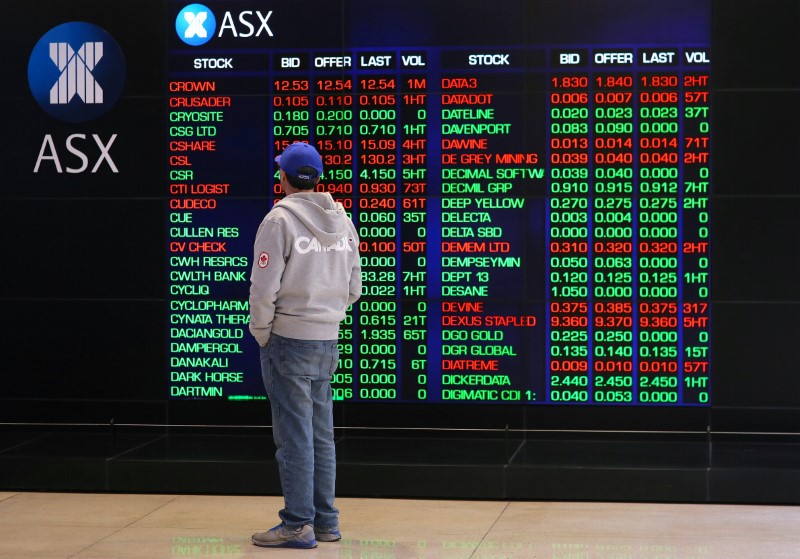The ASX is set to dip today. ASX 200 futures are down 0.2% to 7,898 points.
The dip follows a solid week for the local bourse last week, with the ASX200 finishing 193 points (+2.49%) higher at 7,971 supported by tailwinds from Wall Street, solid corporate earnings and the latest jobs report showing the Australian labour market remains in good shape.
On Friday, the index gained 1.21%, closing at 7,914, surpassing its 20-day moving average. Mining companies had a strong session, with Fortescue (ASX:FMG) Metals Group rising by 2.3%, Rio Tinto (ASX:RIO) Group by 1.42% and BHP (ASX:BHP) by 1.5%.
The strongest sectors last week were IT up 6.02%, Consumer Discretionary which gained 5.28%, Financials made 4.77% and Telcos up 3.72%. On the opposite side, Utilities lost 2.31%, Materials dipped 1.26% and Health Care lost 0.13%.
“This week, the key event on the local data calendar is Tuesday's RBA meeting minutes, which are expected to reiterate the hawkish tone in the statement accompanying the August Board Meeting and RBA Governor Michele Bullock's comments last week that it would be "premature to be thinking about rate cuts," IG Markets Tony Sycamore said.
“However, the rates market paints a different picture, with 20 basis points of RBA rate cuts priced in by year-end and three full 25bp rate cuts by July.
"Elsewhere, the Australian June half-profit reporting season picks up speed, with earnings reports scheduled this week from companies including Lend Lease, Blue Scope, Hub 24, Santos, IAG (LON:ICAG), Sonic and Stockland.”
US extends gains
US equity markets finished the week on a high note, extending gains after economic data helped dispel August's earlier market jitters. Softer inflation figures, solid retail sales, a dip in unemployment claims and a stronger-than-expected Michigan consumer confidence print all contributed to the gains and eased recession fears.
“This week's spotlight is firmly on the Jackson Hole Symposium, which will occur from August 22-24 and has the theme 'Reassessing the Effectiveness and Transmission of Monetary Policy'. Fed chair Jerome Powell is scheduled to deliver his much-anticipated address at 10am ET on Friday,” Sycamore said.
“Powell is expected to strike a dovish tone, though he'll likely refrain from giving explicit policy guidance. The size of anticipated rate cuts in September and beyond seems set to hinge crucially on upcoming labour market data, making the August employment report due on September 6 a pivotal piece of the rate cut jigsaw puzzle.
“The rates market starts the week pricing in 31bp of Fed rate cuts for the September 19 FOMC meeting and 95 bp of cumulative rate cuts before year-end. A reminder that just two Mondays ago, the rates market was at panic stations and pricing in 42bp of Fed rate cuts for September with a cumulative total of 115 bp of rate cuts before year-end.”
Mixed results in Europe
European sharemarkets presented a mixed performance on Friday.
Auto stocks led sectoral gains, increasing by 1.1%, driven by a 3.1% rise in Ferrari (NYSE:NYSE:RACE) shares. Bayer (ETR:BAYGN) surged by 10.4% following a legal victory that could limit its liability in cases alleging that its Roundup weed killer causes cancer.
The FTSEurofirst 300 index, which covers the continent, advanced by 0.3%. Over the week, the index gained 2.5%, marking its strongest weekly performance since early May.
Meanwhile, in London, the UK FTSE 100 index edged down by 0.4% after British retail sales grew by 0.5% in July, slightly below the expected 0.6% increase. Despite the dip, the index rose 1.8% over the week.
Mixed currency movements and commodity price fluctuations dominate global markets
Currencies
Currencies were mixed against the US dollar during European and US trading sessions.
- The Euro appreciated, climbing from US$1.0976 to a session high near US$1.1030 by the US market close.
- The Australian dollar also advanced, rising from US$0.6623 to US$0.6670, holding steady at US$0.6665 by the close.
- The Japanese yen strengthened, moving from 149.08 yen per US dollar to a session high near JPY147.60 by the US close.
Commodities
Global oil prices declined by nearly 2% on Friday as investor optimism about demand growth from China, the world's top oil importer, waned.
- Brent crude fell by US$1.36, or 1.7%, to US$79.68 per barrel.
- The US Nymex crude price dropped US$1.51, or 1.9%, to US$76.65 per barrel.
- Brent finished the week flat, while Nymex edged down 0.2% despite volatile trading.
Base metal prices declined on Friday.
- Copper futures slipped 0.3% after BHP announced a deal with a labour union to resolve a strike at its Escondida copper mine in Chile, easing supply concerns.
- Aluminium futures decreased by 0.1%. For the week, copper gained 3.7% while aluminium rose 2.4%.
- Gold futures surged by US$45.40, or 1.8%, to a record high of US$2,537.80 per ounce on Friday, as the US dollar weakened on expectations of rate cuts and heightened tensions in the Middle East boosted demand.
- Spot gold was trading near US$2,507 per ounce at the US close, with bullion rising 2.6% for the week.
- Iron ore futures fell by US74 cents, or 0.8%, to US$97.81 per tonne on Friday, marking the fifth consecutive session of losses. Weaker-than-expected steel prices in China contributed to bearish sentiment, leading to a 3.4% decline in iron ore prices for the week, marking the second straight weekly loss.
What about small caps?
The S&P/ASX Small Ordinaries finished Friday 1.40% higher to 3,022.00. Over the five trading days last week, the index was 3.29% higher.
It has been a slow start this morning for news flow, however, you can read about the following and more throughout the day.
